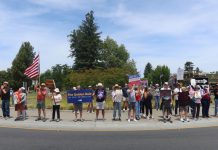Suggested rate increases were decreased following November outcry over initial increase proposals
The Cloverdale City Council voted to move forward with a new set of water and wastewater rate increases, following a public forum and numerous council presentations, brought on by the initial halt to the rate increase process in November, after community members decried the initial set of proposed rates.
The newly proposed rate increases show a significant decrease when compared to the rates proposed in November 2020, but still outline yearly increases that are larger than Cloverdalians have seen in recent years. The new proposed water rates outline a 6% increase in July 2021 and a 12% increase in July each year, from 2022 to 2025. The proposed wastewater rate increases outline a 3% increase in July 2021, with a 10% increase in July each year, from 2022 to 2025. According to Mark Hildebrand of Hildrebrand Consulting, who performed the city’s water rate study, the proposed water rates represent a cumulative increase of 67% over five years (down from the 84% increase proposed in November) and the proposed wastewater rates represent a cumulative increase of 51% (down from the 119% proposed in November).
The council provided city staff with direction to move forward with the new proposed rates during an April 14 council meeting.
The proposed rates will come back to the council on June 9 for a public hearing.
In the name of deferred maintenance
Years of deferred maintenance have helped define the current proposed water and wastewater rate increases — parts of the city’s aging infrastructure need to be repaired or replaced and the city needs to find ways to fund it. However, past annual 3% water and wastewater rate increases are just enough to cover inflation, according Hildebrand.
“Ultimately the rates are going to need to get to a point where they can pay for the annual capital reinvestment that’s going to have to happen every year,” Hildebrand said during a March 24 council meeting.
Hildebrand said legally cities aren’t allowed to charge more for water rates than it needs to run them, meaning the city can’t use water rates as a revenue-generating avenue and that money from rate increases can’t be used to supplement things like the city’s general fund.
Water capital improvements
“There’s been fairly significant deferred maintenance in both our water and our wastewater utility systems. With that said, we understand that it’s often difficult now to progress with a very robust maintenance schedule that requires relatively significant cost increases. What we didn’t want to do was completely eliminate the projects that were driving the rate increases, because we feel that there’s significant risk in doing so,” City Manager David Kelley said during the council’s April 14 meeting.
When looking at what capital improvements are needed, City Engineer Mark Rincon pulled out four water system capital spending projects based on facilities that are “showing their age.” The water facilities Rincon discussed during the council’s April 14 meeting include:
● The Cherry Creek Reservoir, which Rincon said has been in service since 1967. Rincon said that the reservoir is “obsolete in a few factors,” because it doesn’t meet current seismic stability standards, the interior needs a new coating but the city can’t take it out of service because there’s no tank redundancy.
“We’re up against a double-barrel — the aging of the facility, it needs maintenance and it also needs to be basically replaced,” Rincon said. The capital spending for this project comes with a $1.27 million price tag.
● The city’s Ritter Reservoir isn’t as old as its Cherry Creek one (it was put in in 1988), Rincon said, but has a shorter life because it’s a bolted-together, steel-plated tank.
“This one is starting to show leaks throughout its seems, you can see that it has tie-down straps, but it’s probably not sufficient to today’s standards,” he said, adding that the Ritter tank is scheduled for replacement sooner rather than later and that it too needs a new interior coating. The capital spending for the Ritter Tank is expected to be $1.587 million.
● The largest capital improvement the city will have to take on for its water system, Rincon said, is its chlorine contact tank. All water processed through the city has to run through the contact tank.
“This is one facility, it’s been in service for 20 years, it’s never been taken out of service because it’s basically a choke-point in the system … if we lose that tank, we lose potable water, and that’s serious,” Rincon said.
Rincon said that the city wants to add another chlorine contact tank, which would create redundancy and would give the city the ability to alternate tanks in order to take one out to get it serviced. The cost associated with it is $3.07 million.
● Also aging are the water treatment plant’s transfer pumps, which send water into distribution. “The issue there is that mechanical systems don’t last as long and pumps become less efficient over time … we’re looking at a mechanical system that’s overdue for total rehabilitation,” Rincon said.
Wastewater capital improvements
According to Rincon, the wastewater system is currently undergoing video and smoke testing in the city’s older subdivisions, which helps identify areas that need sewer main replacement.
“We’ve been doing a lot of slip lining here — these are interim projects to keep the pipeline intact and flowing, short of replacing the pipelines. These are ongoing to extend the life of the pipeline,” Rincon said.
One thing the wastewater plant is lacking is a SCADA (supervisory control and data acquisition) system, Rincon said, which would allow the city the ability to monitor the plant 24/7.
“Especially as we move into advanced treatment, SCADA is going to be absolutely necessary,” Rincon said.
Additionally, he said that the city’s Shahan Pump Station — a robust system of manholes that collect wastewater that gets pumped out — needs to be rebuilt to modern standards.
“During emergencies when we lose power, we have to man that 24/7 and that’s just not a good situation,” he said. “This facility is beyond its useful life and it needs to be replaced.”
In order to lower the proposed rate increases, Hildebrand said he worked with the city to figure out which deferred maintenance projects could be deferred longer or pushed back to get to achieve lower increases.
“We did undertake quite an effort to try to ensure the long-term health of our utilities but also reduce the burden of the rate impact to your customers and our residents. What we’re trying to seek is really a middle ground between continuing to defer improvements and potentially subjecting our water and wastewater systems to potential long-term costs that really could be greater to our community if we don’t engage in these important maintenance activities,” Kelley said.
According to Hildebrand, the scenario presented to the council on April 14 reflects the least amount of capital spending the city was able to develop without having serious concerns about deferring projects too much.
When going over proposed capital improvement projects, Kelley pointed out that one project, a new well, is marked as being “in development” and will be fully funded from development impact fees and won’t be funded with revenue from water rates.
Impacts of increases and how the city performed public outreach
Rate increases coupled with rising housing prices and a COVID-19-impacted economy combine to create a difficult picture for some Cloverdale residents.
Kelley called the proposed rate increases “relatively bare minimum that address the capital needs of our water and wastewater utilities,” since they include further deferral of some of the city’s capital improvement projects, as well as a lower rate increase for July 2021 to reflect the economic impacts that households have endured during the pandemic.
Critics of the water and wastewater rates have also brought forward concerns about the impact that new development has had on city infrastructure, instead pointing to the way Cloverdale manages continued development in the city and the use of impact fees from new developments.
“Staff really did look at that very carefully and closely and … we maxed out the use of available impact fees to find projects that have relationships to serving new development and growth. That also reduced the cost burden on existing residents and enabled us to reduce some of the rate increase,” Kelley said.
Councilmember Todd Lands asked if the city could negotiate higher development impact fees with developers.
“Basically what we’re setting up is 10% to 20% growth in Cloverdale over the next four years — that’s going to be 10% to 20% more demand on our systems that we’re not taking into account in these numbers,” he said. “It seems like we should be asking for more than just a well or the little bits that we’re pushing. It seems like we should be trying to negotiate more for the taxing and demand that it’s going to be putting on our systems.”
Kelley said that in order for the council to adopt new impact fees, city staff would need to bring forward an updated study in accordance with AB1600.
“There is an opportunity for us, as a next step, to engage in the work of updating our nexus study,” Kelley said, adding that council can choose whether it wants to look at a comprehensive study or a targeted one that just looks at specific areas, like water infrastructure.
Additionally, the only two public comments during the April 14 meeting were from people who were displeased with the level of outreach that the city performed.
“In the five months since the initial proposal, it seems like there’s been two meetings — one a council meeting where the public was invited to comment and the other was a public forum where an hour and 45 minutes were spent with a presentation and 15 to allow for comments. It seems to be like that’s a bit less than anticipated, at least from the comments from the November meeting when we thought that there would be some public input. The fact is that there was very little opportunity for public input until a week or two ago,” Craig Carni said during public comment.
Similar comments were echoed by community member Rob Koslowsky, who submitted a written public comment to the council.
When asked by Councilmember Melanie Bagby about possible outside funding for infrastructure projects, Kelley said that while infrastructure bills are working through the governmental pipeline, the city can’t factor any of them into its budget since they aren’t currently approved.
“We’re not counting on that. We’re counting on being able to fund and build those projects in this rate study,” Kelley said. “That being said, when and if a funding bill is provided for infrastructure, we will seek opportunities to obtain grants to support those projects.”
In many cases, Kelley said that grants and reimbursements require the city to pay for the project up front, with them going back to request reimbursements afterward. Should the city be able to procure a grant during the five-year timeline associated with the rate study, the council has the ability to reevaluate the rate increase for the year, “We’ll have to look at that on an annual basis or … do a check-in to kind of see where we’re at,” Kelley said.
Both Lands and Mayor Jason Turner commended Hildebrand and city staff for their work on establishing the new proposed rates.
Looking back
The rates proposed in November 2020, which have since been tabled, outlined a 13% water increase and 17% wastewater increase on Jan. 1, 2021, with the same increase happening on July 1, 2021 and on each subsequent July 1 through 2024. In the past, the cost of capital improvement projects haven’t been factored into the city’s rates and annual increases have been around 3% per fiscal year.
Discussion about the proposed rates was held in November 2020 and elicited over 894 pages of letters addressed to the city opposing the rate increases. From there, the proposed increases were withdrawn and the council decided to instruct city staff to organize a public forum where community members could learn about and discuss the rates.
The council held one public forum session about the rates on April 7, the two-hour forum had around 45 minutes devoted to public comment, the rest consisted of a presentation about the proposed rates and associated deferred maintenance needs.
{{tncms-inline id=”b1fc3db5-a50a-410a-80c8-3a0b24a8f84e” type=”relcontent”}}









